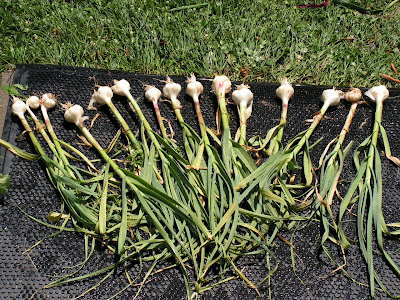
This month's kitchen pilgrimage is lead by an inner longing for a renowned strawberry pie recipe. But how do we know this is a worthy recipe? Here's how: it travels in the hands of the recipe apostles. I first heard of it from a facebook friend who enthusiastically made it after receiving it from its author. Inquiry led me to another facebook-cook who had posted pics of the actual recipe cards, ones she'd received from their author. Lisa herself added comments to those pictures, ones that added further refinements to the recipe framework, but you had to at least take an interest in opening the pictures to see these enhancements--and is anyone else feeling some kind of spiritual resonance in all this? (grin)
Anyway, here is Lisa's snapshot of life in her kitchen to set the tone for us, immediately thereafter you'll find the recipe under discussion:
Our kitchen is a busy place. My husband and I both cook. If it happens on the grill, it's his domain. If it happens in the oven, it's mine. If it happens on the stove top, well, either one of us could be at the helm! My husband grew up with a mother who took cooking lessons from Japanese nuns while the family was stationed in Japan with the Air Force, and she loved to cook delicious gourmet-style meals. He loved to be at her elbow when she did it, too. I grew up with a mom who was a fabulous country cook, transforming the family garden and a freezer full of meat shared from the fall's butchering on the family farm into hearty Midwestern-style meals. I didn't love to be at her elbow, but country cooks need a lot of help to shell peas, snap beans, shuck corn, and prepare to can or freeze all the garden excess (plus extra from local farmers), so I spent time in the kitchen whether I wanted to or not! Our four children are now teenagers and young adults and they are quickly realizing that the fresh, well-prepared food that graces our table isn't the norm in a culture that tends to be too rushed to sit down to eat a home cooked meal, let alone actually learn cooking skills. Good food doesn't have to be fancy or expensive. But freshness, fearlessness with spices and herbs, and a bit of culinary science go a long way towards making restaurant-quality meals on a weeknight basis!
For those who want to cook well but aren't sure how to improve their skills, I highly recommend Cook's Illustrated (www.cooksillustrated.com ) and Cook's Country (www.cookscountry.com ) cooking magazines. Anyone can learn, even if they didn't grow up tied to the elbow of a Chef Mom!
Cooks Illustrated: Home
http://www.cooksillustrated.com/


By the way, Lisa keeps a blog that is just as engaging as her kitchen life sounds. You can find her musings at:
http://heysparky.wordpress.com/
Happy recipe-sharing!
Anyway, here is Lisa's snapshot of life in her kitchen to set the tone for us, immediately thereafter you'll find the recipe under discussion:
Our kitchen is a busy place. My husband and I both cook. If it happens on the grill, it's his domain. If it happens in the oven, it's mine. If it happens on the stove top, well, either one of us could be at the helm! My husband grew up with a mother who took cooking lessons from Japanese nuns while the family was stationed in Japan with the Air Force, and she loved to cook delicious gourmet-style meals. He loved to be at her elbow when she did it, too. I grew up with a mom who was a fabulous country cook, transforming the family garden and a freezer full of meat shared from the fall's butchering on the family farm into hearty Midwestern-style meals. I didn't love to be at her elbow, but country cooks need a lot of help to shell peas, snap beans, shuck corn, and prepare to can or freeze all the garden excess (plus extra from local farmers), so I spent time in the kitchen whether I wanted to or not! Our four children are now teenagers and young adults and they are quickly realizing that the fresh, well-prepared food that graces our table isn't the norm in a culture that tends to be too rushed to sit down to eat a home cooked meal, let alone actually learn cooking skills. Good food doesn't have to be fancy or expensive. But freshness, fearlessness with spices and herbs, and a bit of culinary science go a long way towards making restaurant-quality meals on a weeknight basis!
For those who want to cook well but aren't sure how to improve their skills, I highly recommend Cook's Illustrated (www.cooksillustrated.com ) and Cook's Country (www.cookscountry.com ) cooking magazines. Anyone can learn, even if they didn't grow up tied to the elbow of a Chef Mom!
Cooks Illustrated: Home
http://www.cooksillustrated.com/


By the way, Lisa keeps a blog that is just as engaging as her kitchen life sounds. You can find her musings at:
http://heysparky.wordpress.com/
Happy recipe-sharing!













































